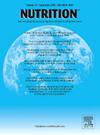Sex differences in the obesity paradox of body compositions in non-small cell lung cancer
IF 3.2
3区 医学
Q2 NUTRITION & DIETETICS
引用次数: 0
Abstract
Objectives
This study investigated the correlation between body mass index (BMI), bioelectrical impedance analysis (BIA)-derived specific body compositions, and the obesity paradox, with a focus on sex differences in non-smallcell lung cancer (NSCLC).
Methods
This study is a multicenter prospective cohort. Association with survival was determined using Cox proportional hazard regression analysis. The mediating effect of systemic inflammation on the association between body composition and survival rate was determined using mediation analysis.
Results
Fat mass had a strong positive correlation with BMI, but a weak positive correlation with other BIA-derived body compositions. Obese, overweight, and normal weight patients had significantly longer median survival than patients with BMI <18.5 ([23.2 versus 18.5 versus 17.5 versus 15.8] months, P < 0.001). Increased BMI and BIA-derived body composition indicators were associated with decreased all-cause mortality. Multivariable-adjusted analysis demonstrated that BMI, fat mass (FM), fat-free mass, muscle mass, bone mass, protein mass, total body water, extracellular water, and intracellular water were independent protective factors affecting the prognosis of patients with NSCLC. A difference in body compositions performance in the prognostic assessment of the different sexes was observed. Fat-related body compositions exhibited a significant obesity paradox in females compared to in males. Systemic inflammation played a crucial role in the relationship between body compositions and disease prognosis, with a mediating effect on body fat in males (31%) and females (19.7%).
Conclusions
The obesity paradox exists among patients with NSCLC and is not influenced by specific body compositions. In addition, this paradox is notably more common in female patients.
Trial registration
Registration number: ChiCTR1800020329
非小细胞肺癌患者身体成分肥胖悖论的性别差异
目的研究体重指数(BMI)、生物电阻抗分析(BIA)衍生的特异性身体成分与肥胖悖论之间的相关性,重点研究非小细胞肺癌(NSCLC)的性别差异。方法本研究采用多中心前瞻性队列研究。采用Cox比例风险回归分析确定与生存率的相关性。采用中介分析确定全身性炎症在体成分与存活率之间的中介作用。结果脂肪质量与BMI呈显著正相关,而与BMI衍生的其他身体成分呈弱正相关。肥胖、超重和正常体重患者的中位生存期明显长于BMI为18.5的患者([23.2 vs . 18.5 vs . 17.5 vs . 15.8]个月,P <;0.001)。BMI和bia衍生的身体成分指标的增加与全因死亡率的降低相关。多变量调整分析表明,BMI、脂肪质量(FM)、无脂质量、肌肉质量、骨量、蛋白质质量、全身水分、细胞外水分和细胞内水分是影响NSCLC患者预后的独立保护因素。在不同性别的预后评估中观察到身体成分表现的差异。与男性相比,脂肪相关的身体成分在女性中表现出显著的肥胖悖论。全身性炎症在机体成分与疾病预后之间的关系中起着至关重要的作用,对男性(31%)和女性(19.7%)的体脂有中介作用。结论非小细胞肺癌患者存在肥胖悖论,且不受特定身体成分的影响。此外,这种矛盾在女性患者中更为常见。试验注册注册号:ChiCTR1800020329
本文章由计算机程序翻译,如有差异,请以英文原文为准。
求助全文
约1分钟内获得全文
求助全文
来源期刊

Nutrition
医学-营养学
CiteScore
7.80
自引率
2.30%
发文量
300
审稿时长
60 days
期刊介绍:
Nutrition has an open access mirror journal Nutrition: X, sharing the same aims and scope, editorial team, submission system and rigorous peer review.
Founded by Michael M. Meguid in the early 1980''s, Nutrition presents advances in nutrition research and science, informs its readers on new and advancing technologies and data in clinical nutrition practice, encourages the application of outcomes research and meta-analyses to problems in patient-related nutrition; and seeks to help clarify and set the research, policy and practice agenda for nutrition science to enhance human well-being in the years ahead.
 求助内容:
求助内容: 应助结果提醒方式:
应助结果提醒方式:


